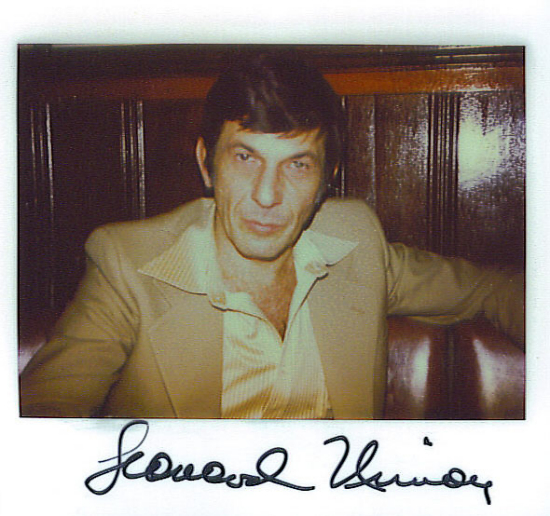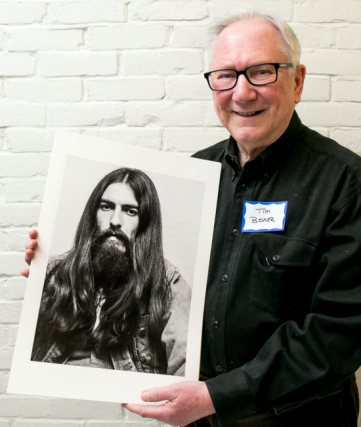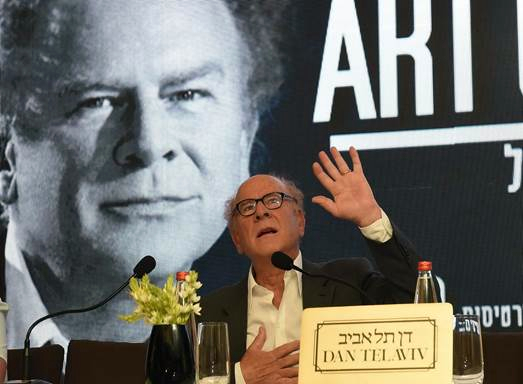|
|
|
|
|
|
|

Polaroid of Leonard Nimoy signed
by the star
Photo by Tim Boxer |
Live Long And Prosper
N 1986 Leonard Nimoy interrupted an extremely hectic
day of post-production of the latest Trekkie epic, Star Trek IV:
The Voyage Home, to welcome me to the Paramount lot in Los
Angeles. Besides continuing his role as Mr. Spock, he was also
director of the film. On his desk I noticed a book, Hannah
Senesh: Her Life and Diary, with an introduction by Abba Eban.
Nimoy was a heavy smoker in his younger
years and was proud he freed himself of the habit the previous year.
"I wasn’t happy about being a smoker," he said. "I was short of
breath. I decided it was time to quit."
His smoking led to
chronic obstructive pulmonary disease (COPD), an incurable malady
that ultimately struck him down on Feb. 27, at home in the Bel-Air
section of Los Angeles. He was 83.
Ironically, while Nimoy found huge success
in Hollywood, he told me the biggest mistake in his career was going
to the West Coast instead of Broadway after leaving Boston College
at age 18. He accepted an offer to work at the Pasadena Playhouse.
"It was not a good idea," he said. "The
Pasadena Playhouse was on its last legs when I got there in 1949. I
wasn’t very happy with the place."
He felt that all those lean years of his
career could have been avoided had he gone straight to New York for
a richer theatrical grounding. But the palm trees swaying on the
sunny boulevards enticed him to stay in L.A. After years of
struggle, he finally rocketed to the top of the Hollywood galaxy
with the Starship Enterprise.
This surge in his career came in 1966-69
when two Jewish boys, Nimoy and William Shatner, dominated on
NBC’s "Star Trek" series. Nimoy’s outlandish pointy ears became a
sensation with sci-fi zealots and a veritable sex object with female
fans. Visitors on the set often felt compelled to reach out and
touch those sexy Vulcan ears.
While it was the producer’s decision that
Nimoy’s half-alien/half-human character, Mr. Spock, should be
greenish, with bangs and pointy ears, it was Nimoy’s choice to reach
back into Jewish tradition to create the unique Vulcan greeting. He
raised his hand, fingers stretched apart, in the manner of Kohanim
when they offer the priestly blessings during holiday services. His
motto was "Live long and prosper."
He was born and bred in a kosher home in
Boston. His father Max, a barber, and mother Dora came
from Zaslav, a small Ukrainian town on the Polish border. He and
brother Melvin went to Hebrew school every day after public
school. "I was very much attached to the social and cultural aspects
of Judaism," he said, "but not terribly attached to the religious
aspects." He was a member of the B’nai B’rith Youth Organization
(BBYO), AZA, and later the Benjamin Cardozo chapter of B’nai B’rith.
He kept his proud Jewish identity strong
over the years. "I feel very good being connected with it, with the
culture and education. I have tried, whenever possible, to work in
projects that have some sense of Jewish identity."
In 1953 he appeared with Yiddish actor
Maurice Schwartz in the English language adaptation of Sholom
Aleichem’s Hard To Be A Jew at the now-defunct Hollywood
Civic Playhouse. That’s where he met his first wife. A replacement
was needed for the ingénue. A beautiful, intelligent woman named
Sandra Zober came to audition. She came from Cordova, Alaska,
the only Jewish family there. She failed the test but gained a
husband. Leonard and Sandi stayed married from 1954 until they
divorced in 1987.
He appeared in a 1971 production of
Fiddler on the Roof in Hyannis, Mass.
Nimoy said doing A Woman Called Golda
was "a very good experience for me." He played Golda Meir’s
husband in that 1982 TV movie. He made two trips to Israel for the
filming. Nine years later, he played a
Holocaust survivor who waged a courtroom battle against Holocaust
deniers in the TV movie Never Forget.
Unlike most Jews in Hollywood, Nimoy
wouldn’t work on Rosh Hashanah and Yom Kippur. "Not as a rule, not
if I can help it," he said.
Nimoy’s second wife, Susan Bay,
whom he married in 1989, survives him. She is a cousin of prominent
film director Michael Bay (Armageddon, Transformers)
who was raised Jewish by adoptive parents.
|
|
Back
to Top |
 |
 ICONIC SHOT
A candid of the
late George Harrison of the Beatles was among the celebrity
portraits I brought to the Fine Art Portfolio Review hosted by the
American Society of Media Photographers. This print, made when I met
Harrison in 1970, is from my Icons of a Century portfolio. ICONIC SHOT
A candid of the
late George Harrison of the Beatles was among the celebrity
portraits I brought to the Fine Art Portfolio Review hosted by the
American Society of Media Photographers. This print, made when I met
Harrison in 1970, is from my Icons of a Century portfolio. |
|
Back
to Top |
 |
|
From Yossel To Gene
EGENDARY Broadway director Gene Saks succumbed on
March 28 from pneumonia at his home in East Hampton, N.Y. He was 93.
He was born in Manhattan as Jean
Michael Saks, and raised in Hackensack, N.J. His mother’s family
came from Germany; his father’s family from Hungary. Gene had his
bar mitzvah at Barney Memorial Temple in Paterson, N.J. "I gave a
good speech," he recalled when I interviewed him.
He said his Hebrew name was Yossel.
His mother didn’t like the name Joey so she named him Jean. "It
bugged me for years. Finally in high school, after a third year of
being in the girls’ gym class, I changed the spelling of my name."
Gene started out as an actor. He first
came to Broadway in the revival of a comedy called Topaze in
1947. It was worse than bad. When reviews came out the next day the
show promptly folded. But don’t blame Gene. He only did a walk-on.
He made his TV acting debut in an episode
of Out There, in 1949, and appeared in Kraft Theater
and The United States Steel Hour. That year he made his
acting debut on Broadway in South Pacific and went on
to appear in more shows including The Tenth Man by Paddy
Chayefsky.
I talked to Gene in 1982 when he was
directing a Morton Gottlieb production of Special
Occasions on Broadway. He had made his debut as a Broadway
director in 1963 with Gottlieb’s production of Enter Laughing.
Later he became known as the favorite director of Emanuel
Azenberg who produced eight Neil Simon shows.
At the time we met, Gene had divorced
Bea Arthur (in 1978) after 29 years of marriage. They had two
sons, actor Matthew and TV set designer Daniel. With
his second wife, Keren Ettlinger (who survives him), he had a
daughter, Annabelle.
Gene and Bea did not raise their sons in
any religion. And that, he believed, was a mistake.
"It’s unwise to have no religious
education," Gene said. "The children should belong to some roots.
The decision to avoid religion was a reaction to one’s parents. It
was also part of the times. In the 40s, religion was not up to date
with the world. It was stagnant. People became disenchanted. And we
were a product of that era."
|
|
Back
to Top |
 |
|
 CHECKING
IN Art Garfunkel, part of the former CHECKING
IN Art Garfunkel, part of the former
folk duo Simon and
Garfunkel, holds press conference at the Dan Tel Aviv, prior to a
performance at the Bloomfield Stadium. He stayed at the hotel for
five nights with his son and entourage. Photo by
Israel Hadari
|
 |
|
Comments |
|
|
|
|
|
|
| This website is under the copyright protection of the
Intellectual Property Laws of the State of New York, the United States and International Treaties. All written content,
design and functionality is © 15MinutesMagazine. Inc, 1999 -
. All images are protected as such. No copying, downloading
or other use of images on this site is permitted without prior written permission.
|
Site
Designed, Developed and Maintained by

Any questions or comments regarding this website,
or if you would like one of your own,
please contact us at internetwebsystems.com |
|
|

|
|
|